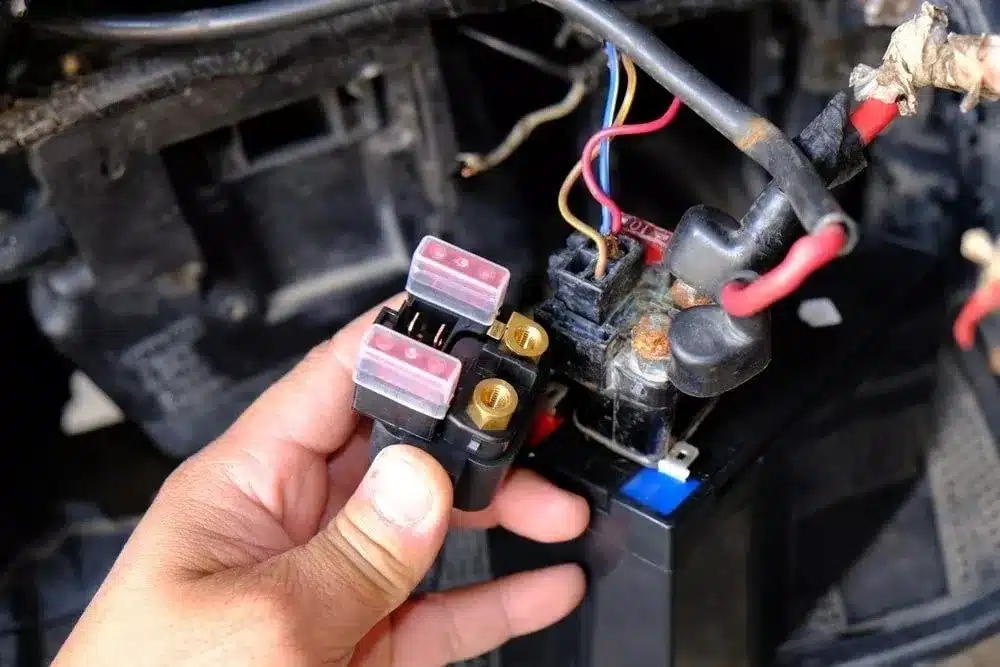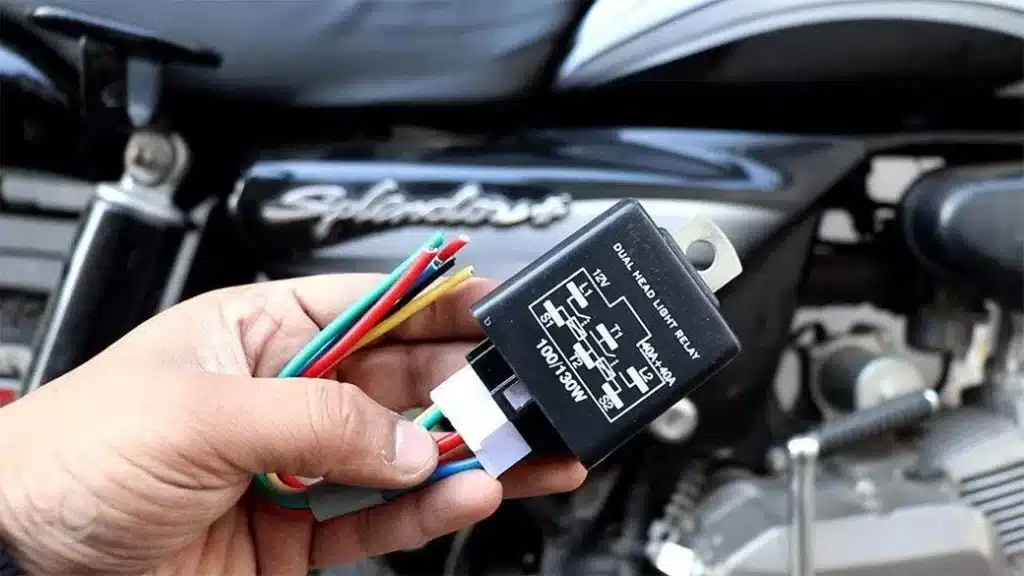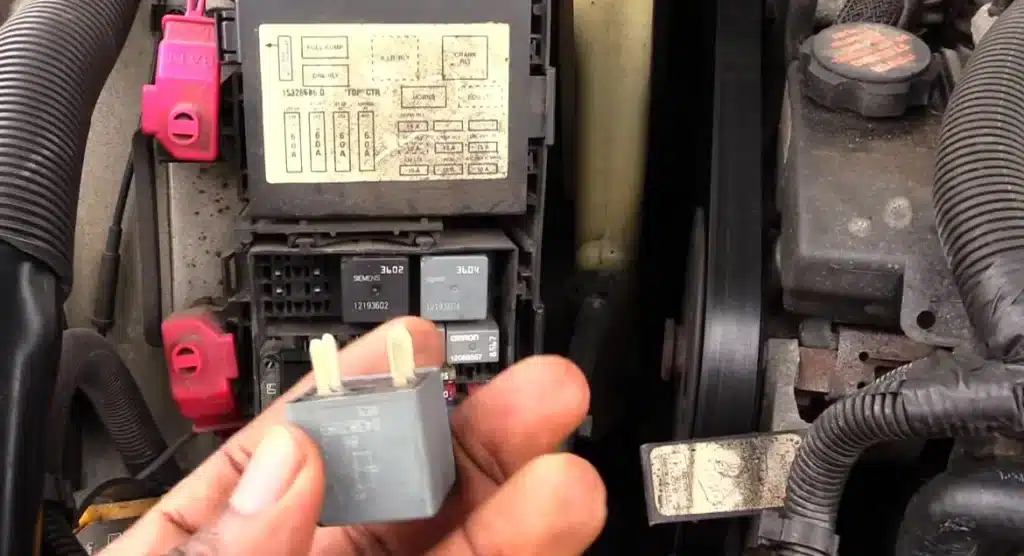Relay



What is a car relay and what is its use
A relay is a piece that not only in the car, but also in various industries you may have heard its name; This piece, which is used in the electrical parts of the car, acts as an electromagnetic key and is used to prevent excessive use of wiring in cars.
Relays, which are used in various parts of the car, are used to disconnect and connect strong currents using a weak current. Many people introduce relays as a switch and consider their most important use in disconnecting and connecting electrical current with high voltage; Just as in many electrical devices such as home appliances, kitchen appliances, etc., a relay is used as a disconnect and connect the electric current.
Relays usually consist of an iron core, a coil, and a platinum plate that are divided into two types of spring and non-spring; In the spring type, a spring is used that is connected to the platinum part, and the non-spring type has a platinum plate with elastic properties.
Where are relays used in a car?
The electrical system of a car is one of the most important systems of a car, and its role in today’s cars, which are based on advanced computer systems, has become more prominent. This system consists of two parts; some of these parts are responsible for generating electricity, and some parts of this system are considered as electricity consumers.
Relays are used in most electrical parts of the car; computer interfaces, starters, various lights, horns, etc. are the most important parts where relays are used.
Car Electrical System
The car’s power supply system, which has a special extent, includes various parts including battery, dynamo, coil, plug, wire, fuse, relay, etc., some of which play a vital role in getting the car moving. Most of these parts that provide the car’s energy are activated from the moment you enter the car and sometimes continue to operate until the last moment.
This system causes other car systems such as cooling and heating systems, lights, start, audio system, glasses, spark system, etc. to work, and by doing this, in addition to starting the car, it also helps the comfort and convenience of the passengers.
The most important components of the car electrical system
The most important components of a car’s electrical system can be classified into five general parts, as previously mentioned.
The parts that are responsible for generating electricity in the car; this task is performed by the alternator or generator, which, in addition to converting the mechanical energy created into 12-watt electricity, also transfers it to the battery to store the generated electricity. This part, which includes the battery, stores the electricity received from the alternator and even keeps it when the car is turned off. The stored electricity in the battery is used for tasks that the car performs when it is turned off.
The part that includes the battery stores the electricity received from the alternator and even keeps it when the car is turned off. The stored electricity in the battery is used for tasks that the car performs when it is turned off.
The electricity generated by the alternator or generator is transferred to other power-consuming parts by a system called the electrical distribution system. This system conducts electricity through wire strands that are visible in most parts of the car .
- Sometimes, systems are needed to manually or automatically disconnect and connect the power supply. These parts are called car electrical controllers. Relays and switches that disconnect and connect the power supply are among these parts.
- The fifth group of car electrical system components are power consumers that are located in various parts of the car. These parts include the starter, heating and cooling system, windows, lights, cooler, and more.

What is a dual relay?
A dual relay is a component that, when broken or not working properly, can cause injector cars to turn off or have trouble turning on. This part, which is made up of two relays stuck together, has 15 pins and is connected to the car’s wiring harness via an interface.
One of these relays, which together form the dual relay by connecting to each other, is known as the main relay, and the other relay is called the fuel pump relay. The electricity for systems such as sensors, computers or power supplies (ECU), ignition system, injectors, coils, fuel pumps, and fuel delivery systems is supplied by this relay, which is powered by 12-volt electricity.
In other words, the dual relay is responsible for transferring electricity to the electrical components mentioned above; these components are considered the most important electrical components of cars and, if there is a problem with any of them, your car may not turn on or may not work properly when turned on.
Dual relay location in car
The dual relay, which is about the size of a palm, is located in different places depending on the type of car. In most cars, this relay is placed next to the engine and usually behind the driver’s side light and is attached to the body with a screw. This part may be installed next to the battery, next to the radiator, or next to the ECU in some cars.
Each of the relays in the dual relay, which is usually produced and sold in black like the relays used in different parts of the car, has a coil wire and a contactor.
Double relay function
The dual relay is designed and used to prevent extra wiring and automatically activate an electrical circuit. It operates in three stages: switch closed, switch open, and motor on. Failure or malfunction in any of these three stages prevents the car from turning on.
The first stage is the switch closed stage, in which a 12-volt current is sent by the relay to the car’s computer (ECU).
The second stage is the switch open stage, in which the ECU sends a 12-volt voltage to injectors, fuel pump, coils, electrical valve, and sensors. The duration of sending this voltage is about 2 to 3 seconds.
The last stage is the stage in which the engine is turned on. In this stage, when the switch is fully rotated and the car engine is turned on, the dual relay sends a 12-volt voltage to the parts mentioned in the previous stage on a permanent basis.
Double relay failure test
Relays are components that, in addition to their appearance, have methods for testing them; car electrical specialists, in the first step, can diagnose the malfunction of this part by reviewing and observing its appearance. The most important signs that make it possible to diagnose the malfunction of the relay by observing them are the presence of signs of sulfation in the relay socket; this work is done only by specialists in this field, and not everyone is capable of performing this test.
After examining the symptoms and not observing the effects of sulfation in the relay socket, it is possible to diagnose the malfunction by connecting the diagnostic device to the car and testing its performance. The diagnosis of malfunction is usually done by testing the fuel pump with a diagnostic device and hearing the sound of platinum; in this test, if the power is connected and the sound of platinum is not heard, it is concluded that the relay is damaged.
One of the methods for testing the relay is voltage testing, in which after checking the connections and fuse box, the battery voltage is measured by a device called a voltmeter, and in this way, the malfunction of the relay is diagnosed. In this method, the socket must be disconnected from the relay.
The last method that electrical specialists usually use to test the relay is to use a device called an ohmmeter; by connecting this device to some of the relay pins and displaying constant values in these pins, the malfunction of the relay can be diagnosed.

Possible failures in the double relay
One of the common problems that may occur with the dual relay is the burning of the relay pins. As previously explained, relays are used as power suppliers for parts such as injectors, fuel pumps, ECUs, coils, and more. Any problem in the path of these parts or their partial burning causes a high-ampere current to pass through the relay, which can create heat and ultimately burn the relay pins.
Due to the limited lifespan of the relay and its internal components, at any moment, the expiration of the useful life of these parts may cause it to fail and not work. This happens more often with relay coils, and the most important sign of its failure is the failure of the check light on the dashboard to turn on when the car switch is turned on.
People who have some information about relays, when this part has a problem and causes the car not to turn on, perform several simple steps to bypass the relay and temporarily turn on the car. To repair or replace it, they go to car electrical repair shops. This operation is performed in different ways in different cars, and in some cars, it is impossible due to their special structure.
What are the symptoms of relay failure?
The car is made up of various mechanical, hydraulic, and electrical components, each of which performs specific tasks in its operation. Some of these parts are highly sensitive, while others are of little importance due to their low impact on the car’s performance and are sometimes used as a facilitator for the driver or passengers in various parts of the car.
The car’s electrical system, as the first system used to turn on the car, is one of the systems that should be given more attention and special sensitivity to its malfunctions.
The malfunction of the relay disrupts the most important function of the car, which is turning on and moving; the first sign described for relay failure is the failure of the car to turn on. This sign may also be due to problems with other parts, but it can also be considered one of the signs of relay failure.
When you turn the switch in injector cars, you will probably hear a weak sound that is caused by the fuel pump turning on for about 3 seconds. The failure to hear this sound when turning on the switch is another sign that can alert you to relay failure.
The dashboard behind the steering wheel has indicators that show you problems and malfunctions in different parts of the car. When you turn the switch, before the car engine turns on, some of the lights in this section start to turn on. One of the lights that should turn on at this moment and remain on is the check engine light. Failure of this light to turn on in the open switch state and before the engine starts is another sign of relay failure.
It should be noted that the check engine light should turn on before the engine starts and turn off as soon as the driver starts the car by turning the switch. If this light remains on during engine operation, it indicates a problem or malfunction in other parts of the car that must be resolved by visiting authorized repair shops and testing with diagnostic equipment.
If your car starts when you turn the switch but does not turn on, it is also possible that the relay is malfunctioning or damaged.

What is the difference between relay and fuse?
Relays and fuses are both considered parts of the car’s electrical system, but they have different functions. The fuse, which is made of a heat wire, by showing a reaction to abnormal current or voltage fluctuations, prevents damage to other parts by cutting off this current. This part is known as a protective part and is usually made of copper and lead.
However, as previously explained, the relay, as a part that functions like a switch, prevents manual connection and disconnection of electric current and does this automatically. In addition to this function, the relay is used to transfer low-voltage electrical current by a weak voltage.
With these explanations, it can be seen that these two parts, although they are part of the car’s electrical system and despite their small size and volume, are of great importance in this system and have completely different functions and functions designed for specific purposes in cars.
Maintenance of vehicle electrical system components
The car’s electrical system, like other car systems, needs care and maintenance, which, in addition to reducing the cost of repairing and replacing them, increases the lifespan of these parts.
The parts and components of this system are very numerous, and each has a separate property. However, due to the operation of the parts of this system with electricity and electric current, they usually need to be protected against heat, cold, and moisture and should be periodically visited.
The simultaneous use of car electrical parts can create pressure on this system and, by increasing the wear and tear of its parts, reduce the lifespan of these parts.
Keeping the car’s electrical system parts clean is one of the factors that prevent ringing and corrosion of the parts of this system and can significantly affect the performance of these parts.
Due to the speed of changes and advances in car electrical system parts and components, it is essential to refer to electrical specialists who are familiar with the latest car science and have sufficient and up-to-date information in this field and specify a time for periodic visits to this system.
For the import of various types of spare parts, including spare parts for domestic and foreign cars, contact Tata Trading Company. Our connection with various companies around the world enables us to provide you with the best and highest quality spare parts from different brands, bringing you a profitable and easy trade.

